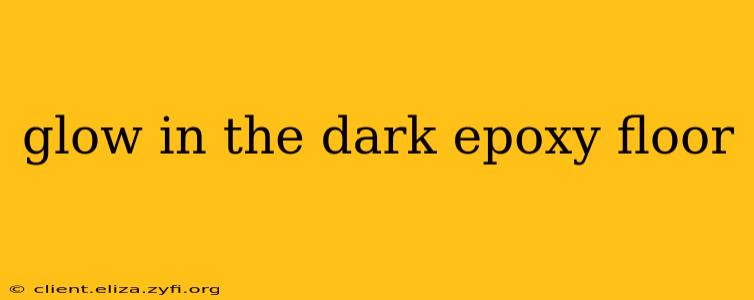Glow-in-the-dark epoxy floors have become increasingly popular for their unique aesthetic appeal and practical applications. From adding a dramatic touch to a nightclub to enhancing safety in dimly lit areas, these floors offer a captivating and functional solution. This comprehensive guide will delve into everything you need to know about glow-in-the-dark epoxy flooring, covering installation, maintenance, and potential applications.
What is Glow-in-the-Dark Epoxy Flooring?
Glow-in-the-dark epoxy flooring combines the durability and shine of epoxy resin with the luminescence of phosphorescent pigments. These pigments absorb ambient light (natural sunlight or artificial light) and then release it gradually in the dark, creating a captivating glow. Unlike fluorescent materials, which require a continuous light source, phosphorescent pigments offer a sustained glow, making them ideal for this application. The epoxy acts as a protective layer, securing the pigments and creating a seamless, hard-wearing surface.
How is Glow-in-the-Dark Epoxy Flooring Installed?
The installation process for glow-in-the-dark epoxy flooring is similar to standard epoxy flooring, but with the added step of incorporating the phosphorescent pigments. Proper surface preparation is crucial for optimal adhesion and a long-lasting finish. This typically involves cleaning, grinding, and priming the existing floor. The epoxy resin, mixed with the glow powder, is then applied in multiple coats, allowing each coat to cure completely before the next application. The amount of pigment added will directly impact the brightness and duration of the glow. A professional installation is often recommended to ensure a flawless and durable result.
How Long Does Glow-in-the-Dark Epoxy Flooring Glow?
The duration of the glow depends on several factors, including the type and quality of phosphorescent pigment used, the intensity of the charging light source, and the environmental conditions. High-quality pigments can offer a glow lasting several hours after being exposed to light. The brighter the initial charge (exposure to light), the longer and brighter the glow will be. However, the glow will gradually diminish over time, requiring recharging with a light source.
What are the Different Types of Glow-in-the-Dark Epoxy Pigments?
Several types of phosphorescent pigments are available, each with varying properties in terms of brightness, glow duration, and color. Some pigments offer a vibrant, intense glow, while others provide a softer, more subtle luminescence. The choice of pigment will depend on the desired aesthetic and the specific application. Researching different pigment options and their characteristics is crucial for achieving the desired effect.
How Much Does Glow-in-the-Dark Epoxy Flooring Cost?
The cost of glow-in-the-dark epoxy flooring varies depending on several factors, including the size of the area, the type of pigment used, the complexity of the design, and the labor costs. Generally, it’s more expensive than standard epoxy flooring due to the cost of the specialized pigments. Getting multiple quotes from different contractors is recommended to ensure you get a competitive price.
How Do I Maintain Glow-in-the-Dark Epoxy Flooring?
Maintaining glow-in-the-dark epoxy floors is relatively straightforward. Regular sweeping or vacuuming will remove loose dirt and debris. Occasional mopping with a mild detergent solution will help maintain its shine and cleanliness. Avoid using harsh chemicals or abrasive cleaners, as these can damage the epoxy surface and diminish the glow.
Is Glow-in-the-Dark Epoxy Flooring Suitable for All Areas?
While glow-in-the-dark epoxy flooring is versatile, it's essential to consider the application. It's ideal for areas where a unique aesthetic is desired and low-light visibility is beneficial, such as nightclubs, theaters, or certain industrial settings. However, it may not be suitable for all environments, particularly those exposed to extreme temperatures or harsh chemicals.
What are the Safety Considerations for Glow-in-the-Dark Epoxy Flooring?
The safety of glow-in-the-dark epoxy flooring primarily revolves around the selection of materials. Ensure the pigments and epoxy resin used are non-toxic and comply with relevant safety standards. Proper ventilation during installation is crucial to minimize exposure to fumes. Furthermore, consider the potential for slippage, especially in wet conditions. Applying a non-slip additive to the epoxy mix can mitigate this risk.
This comprehensive guide provides a solid foundation for understanding glow-in-the-dark epoxy floors. Remember to research thoroughly and consult with professionals to ensure a successful and safe installation that meets your specific needs and expectations.
